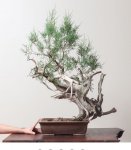SantaFeBonsai
Shohin
- Messages
- 424
- Reaction score
- 4,376
Would you rather see a rmj with its original foliage, albeit a little spindly, stay true to its roots or grafted with a Japanese cultivar essentially becoming a hybrid of sorts? Does grafting add value over the original foliage? Seeing kishu on a rmj looks too perfect for me and not natural. I personally like the whimsically look of collected rmj foliage.
It has been suggested that grafting would be the best option with a rmj I just purchased. This would add several years to the project,,, or we could style now and have a legit tree.
It has been suggested that grafting would be the best option with a rmj I just purchased. This would add several years to the project,,, or we could style now and have a legit tree.

